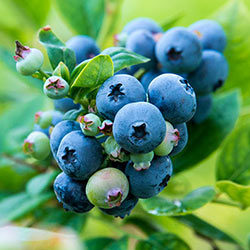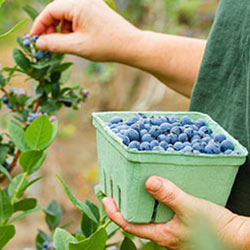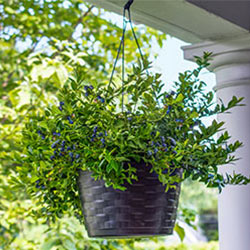Blueberry Plants and Bushes
Blueberry bushes belong in every home garden! Not only do they produce deliciously sweet and healthful fruits, but the four to six-foot shrubs make beautiful landscape plants. Have a smaller space? No problem. Choose a blueberry bush of the dwarf variety and plant it in a container. Gurney's Seed & Nursery Co. carries a wide selection of blueberry plants for sale to suit your space.
How to Grow Blueberry Plants
Blueberry Bushes for Sale From Gurney's

Gurney's carries many different varieties of large and small blueberry bushes. Our team of experienced horticulturists search every year for the best new varieties, and before any variety is sold, we grow and test it on our farm in Ohio. We plant each blueberry plant variety in a manner that mimics home gardening conditions, ensuring no plant requires excessive effort. We then study and test how the blueberry bush holds up to pests and stressors like inclement weather, as well as their flavor, level of growing difficulty, yield, and appearance. If a plant doesn't meet our standards, we don't sell it to our customers.
First-year plants rarely produce fruit, and it's actually better in the long run if they don't. It's also important to note that having multiple varieties of blueberries planted together is ideal for optimal pollination. Though all of our blueberry plants are self-fruitful, they will produce better crops and higher yields if more than one variety is planted.
Let's look at the specifics of planting blueberries you should know before purchasing.
Choosing the Right Blueberry Bushes & Shrubs
Some blueberry bushes are better suited for certain areas and conditions. To learn which variety will grow best for you, let's look at the different blueberry bush varieties and their requirements.
Northern Highbush Blueberries
Northern Highbush blueberries are very common. They're suitable for growth in hardiness zones three through eight, making them an ideal choice for colder climates. Don't worry northerners--you, too, can grow blueberries! These bushes are native to eastern Northern America and grow well in moist, acidic soils.
Southern Highbush Blueberries
Southern Highbush blueberries are not as hardy as northern varieties. They have lower chill-hour requirements and bloom earlier. These blueberry bushes are more tolerant of heat and drought and show greater resistance to disease and insect pests. This variety is best suited for the Southeast, Mid-Atlantic, lower Midwest, Southern California, and Pacific Northwest areas.
Lowbush Blueberries
The Lowbush blueberry plant is native to the northeastern United States and eastern Canada. This variety is commonly found in your grocery store's freezer thanks to its intense blueberry flavor. Lowbush blueberry bushes prefer very acidic, shallow soil.
Rabbiteye Blueberries

This variety of blueberry bush can grow up to 20 feet tall and thrives best in hardiness zones seven to nine. They require fewer chill hours and bloom earlier than northern varieties. Rabbiteye blueberry bushes are tolerant of more alkaline soils, are easy to grow, and are more resistant to disease and insect pests.
Blueberries are truly a wonderful addition to any yard or garden. The flavor of the fruit and the three-season color and beauty is unbeatable. It is important to know before starting your journey with blueberries bushes, that they do require patience.
Planting Blueberry Bushes
Blueberry plants are most often grown in the ground but also grow quite nicely in containers if you're short on yard space. Growing blueberries is fairly easy as long as you follow a few requirements. Consult the list of varieties above to see which type of plant will be better suited for your growing conditions and follow the instructions below to grow your blueberry bush.
How to Plant Blueberry Bushes
If possible, get your soil ready a year ahead of planting your blueberry bush. Blueberry bushes prefer more acidic soil with a pH of about five. Good drainage, fertilization, and sulfur can help blueberries tolerate more alkaline soil, however. A soil test can help determine the pH of your soil. Peat moss and pine bark tilled into a mounded bed helps lower soil pH if needed.
Water is critical to growing blueberries, as they're shallow-rooted plants that require frequent watering. Fertilize the bushes with a fertilizer blend specifically formulated for acid-loving plants. If you're growing in a container, combine a high-quality potting mix with fertilizer and peat moss.
When to Plant Blueberry Bushes

Blueberry bushes are planted in cooler months, usually between November and February. The ideal time to plant is before the end of December, however. The earlier you plant within this time window, the more time plants have to establish their roots before spring, giving them a stronger start.
Where to Plant Blueberry Bushes
Hardiness zones are important to keep in mind when planting blueberry bushes, as is drainage. A sunny location is preferred. Plant your bed where it can get full or at least partial sun, acidic soil, and regular watering. Roots must be able to stay moist during the growing season, but adequate soil drainage is still required to prevent sogginess.
How to Grow and Care for Blueberries
Weed control is essential for blueberry bushes. Eliminate weeds as much as possible to allow blueberries to thrive. Do not prune the plant for the first two years. Remove fruit buds the first year to help establish the root system and support vegetation. Lastly, consider netting to protect your blueberry bushes from birds and rodents.
Harvesting Blueberries
The blueberry harvest time depends on the location and variety. In warmer climates, blueberries may ripen as early as June. In other areas if may be July or August. Harvest blueberries as they ripen on the bush. You can tell when the blueberries are ripe by their appearance and feel. They should be blue and slightly springy. When harvesting blueberries, gently pull the berries off of the bush. Place the berries in the refrigerator after harvest. Store the berries in shallow containers and avoid layering the berries more than a few inches high.





 Gardens Alive! & Supplies
Gardens Alive! & Supplies






